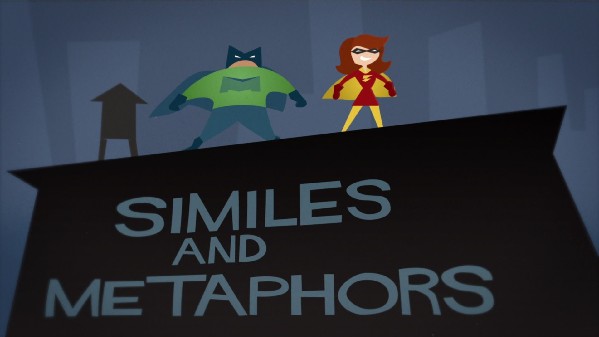當前位置: Language Tips> 考試培訓
分享到
除了最常見的明喻、暗喻、擬人,英語中還有很多修辭手法。有一些可能是你經常見到卻沒有意識到的。

1. Simile 明喻
明喻是將具有共性的不同事物作對比。這種共性存在于人們的心里,而不是事物的自然屬性。
標志詞常用 like, as, seem, as if, as though, similar to, such as等。
例如:
1). He was like a cock who thought the sun had risen to hear him crow.
2). I wandered lonely as a cloud.
3). Einstein only had a blanket on, as if he had just walked out of a fairy tale.
2. Metaphor 隱喻,暗喻
隱喻是簡縮了的明喻,是將某一事物的名稱用于另一事物,通過比較形成。
例如:
1). Hope is a good breakfast, but it is a bad supper.
2). Some books are to be tasted, others swallowed, and some few to be chewed and digested.
3. Metonymy 借喻,轉喻
借喻不直接說出所要說的事物,而使用另一個與之相關的事物名稱。
I、以容器代替內容,例如:
1).The kettle boils.
水開了。
2).The room sat silent.
全屋人安靜地坐著。
II、以資料、工具代替事物的名稱,例如:
Lend me your ears, please.
請聽我說。
III、以作者代替作品,例如:
a complete Shakespeare 莎士比亞全集
IV、以具體事物代替抽象概念,例如:
I had the muscle, and they made money out of it.
我有力氣,他們就用我的力氣賺錢。
4. Synecdoche 提喻
提喻用部分代替全體,或用全體代替部分,或特殊代替一般。
例如:
1). There are about 100 hands working in his factory.
(部分代整體)他的廠里約有100名工人。
2). He is the Newton of this century.
(特殊代一般)他是本世紀的牛頓。
3). The fox goes very well with your cap.
(整體代部分)這狐皮圍脖與你的帽子很相配。
5. Synaesthesia 通感,聯覺,移覺
這種修辭法是以視、聽、觸、嗅、味等感覺直接描寫事物。通感就是把不同感官的感覺溝通起來,借聯想引起感覺轉移,“以感覺寫感覺”。
例如:
1)The birds sat upon a tree and poured forth their lily like voice.
(用視覺形容聽覺,鳥落在樹上,由它發出的聲音聯想到百合花)
鳥兒落在樹上,傾瀉出百合花似的聲音。
2)Taste the music of Mozart.
(用嗅覺形容聽覺)品嘗Mozart的音樂。
6. Personification 擬人
擬人是把生命賦予無生命的事物。
例如:
1)The night gently lays her hand at our fevered heads.
(把夜擬人化)
2)I was very happy and could hear the birds singing in the woods.
(把鳥擬人化)
7. Hyperbole 夸張
夸張是以言過其實的說法表達強調的目的。它可以加強語勢,增加表達效果。
例如:
1)I beg a thousand pardons.
2)Love you. You are the whole world to me, and the moon and the stars.
3)When she heard the bad news, a river of tears poured out.
8. Parallelism 排比,平行
這種修辭法是把兩個或兩個以上的結構大體相同或相似,意思相關,語氣一致的短語。句子排列成串,形成一個整體。
例如:
1)No one can be perfectly free till all are free; no one can be perfectly moral till all are moral; no one can be perfectly happy till all are happy.
2)In the days when all these things are to be answered for, I summon you and yours, to the last of your bad race, to answer for them. In the days when all these things are to be answered for, I summon your brother, the worst of your bad race, to answer for them separately.
9. Euphemism 委婉,婉辭法
婉辭法指用委婉,文雅的方法表達粗惡,避諱的話。
例如:
1)He is out visiting the necessary. 他出去方便一下。
2)His relation with his wife has not been fortunate. 他與妻子關系不融洽。
3)My mother passed away in 1997. (去世)
10. Allegory 諷喻,比方(原意“寓言”)
建立在假借過去或別處的事例與對象之上,傳達暗示,影射或者譏諷現世各種現象的含義。
例如:
1)Make the hay while the sun shines.
表層含義:趁著出太陽的時候曬草
真正意味:趁熱打鐵
2)It's time to turn plough into sword.
表層含義:是時候把犁變成劍
真正意味:要開戰了
11. Irony 反語
反語指用相反意義的詞來表達意思的作文方式。如在指責過失、錯誤時,用贊同過失的說法,而在表揚時,則近乎責難的說法。
例如:
1)It would be a fine thing indeed not knowing what time it was in the morning.
早上沒有時間觀念還真是一件好事啊(真實含義是應該明確早上的時間觀念)
2)"Of course, you only carry large notes, no small change on you. "the waiter said to the beggar.
服務生對那個乞丐說:“當然了,你身上只有大鈔,不會有零錢的。”
12. Pun 雙關
雙關就是用一個詞在句子中的雙重含義,借題發揮。作出多種解釋,旁敲側擊,從而達到意想不到的幽默、滑稽效果。它主要以相似的詞形、詞意和諧音的方式出現。
例如:
1)She is too low for a high praise, too brown for a fair praise and too little for a great praise.
2)An ambassador is an honest man who lies abroad for the good of his country.
3)If we don't hang together, we shall hang separately.
13. Parody 仿擬
這是一種模仿名言、警句、諺語,改動其中部分詞語,從而使其產生新意的修辭。
例如:
1)Rome was not built in a day, nor in a year.
2)A friend in need is a friend to be avoided.
14. Rhetorical question 修辭疑問(反問)
它與疑問句的不同在于它并不以得到答復為目的,而是以疑問為手段,取得修辭上的效果,其特點是:肯定問句表示強烈否定,而否定問句表示強烈的肯定。它的答案往往是不言而喻的。
例如:
1)How was it possible to walk for an hour through the woods and see nothing worth of note?
2)Shall we allow those untruths to go unanswered?
15. Antithesis 對照,對比,對偶
這種修辭指將意義完全相反的語句排在一起對比的一種修辭方法。
例如:
1)Not that I loved Caeser less but that I loved Rome more.
2)You are staying; I am going.
3)Give me liberty, or give me death.
16. Paradox 雋語
這是一種貌似矛盾,但包含一定哲理的意味深長的說法,是一種矛盾修辭法。
例如:
1)More haste, less speed.
欲速則不達。
2)The child is the father to the man.
(童年時代可決定人之未來)三歲看大,四歲看老。
17. Oxymoron 反意法,逆喻
這也是一種矛盾修辭法,用兩種不相調和的特征形容一個事物,以不協調的搭配使讀者領悟句中微妙的含義。
例如:
1)No light, but rather darkness visible.
2)The state of this house is cheerless welcome.
18. Climax 漸進法,層進法
這種修辭是將一系列詞語按照意念的大小、輕重、深淺、高低等逐層漸進,最后達到頂點。可以增強語勢,逐漸加深讀者印象。
例如:
1)I am sorry, I am so sorry, I am so extremely sorry.
2)Eye had not seen nor ear heard, and nothing had touched his heart of stone.
19. Anticlimax 漸降法
與climax相反的一種修辭法,將一系列詞語由大到小,由強到弱地排列。
例如:
1)On his breast he wears his decorations, at his side a sword, on his feet a pair of boots.
2)The duties of a soldier are to protect his country and peel potatoes.
(來源:有道考神,編輯:Helen)
上一篇 : 雅思作文高分套路
下一篇 : 英語六級作文常用100個短語
分享到
關注和訂閱

電話:8610-84883645
傳真:8610-84883500
Email: languagetips@chinadaily.com.cn